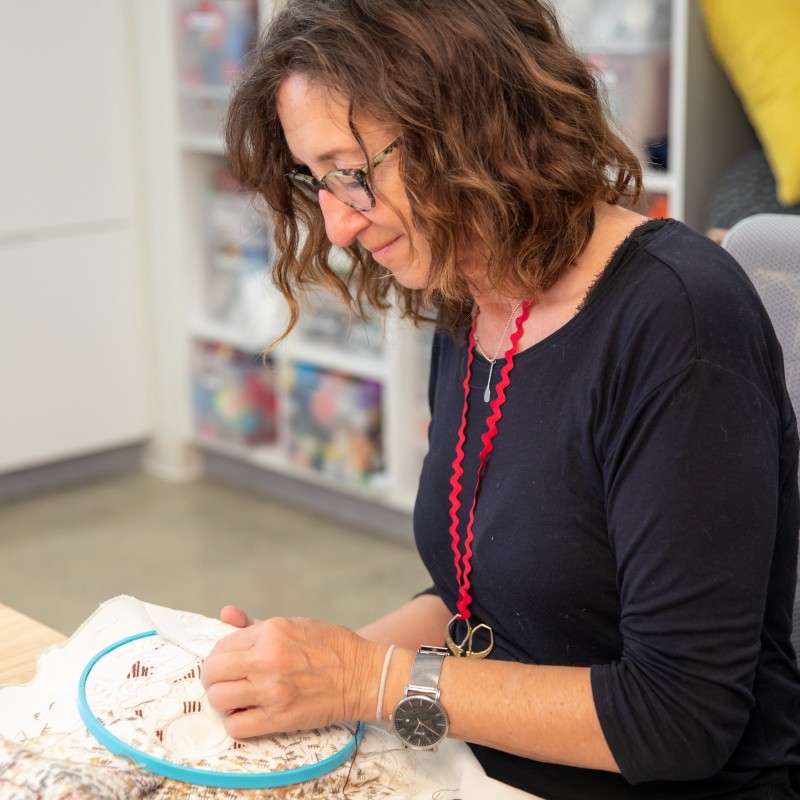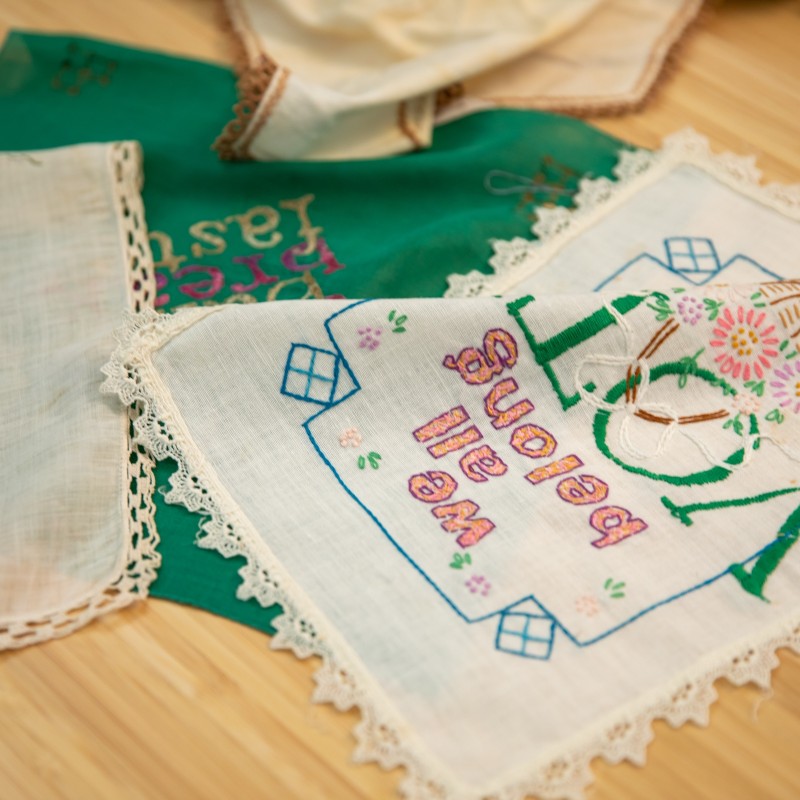Michelle Montjoy lives in Oceanside, California, where she creates installations, sculptures, embroidery, and socially engaged projects. A past recipient of Creative Catalyst and California Arts Council grants, her work has been shown at MCASD, Art Produce Gallery, ICA North, the San Diego International Airport, The New Children’s Museum, and more. Recently, Michelle stopped by the Museum to prep for her upcoming workshop, Mending Memories, and chatted with us about her work today and her love for making.
"Each stitch marks a moment in time, and the accrual of these small intimate actions gather into a magnificent whole."
Can you share a little about your background in art?
Like most children, I loved to draw and was given encouragement and a lot of scrap paper. Our family moved every few years and often lived in the hotels that my father managed. We had a lot of unstructured time, and my mom admonished us that boredom (and cursing) were signs of an unimaginative mind. She was a child of the Depression, and we were raised to be responsible and resourceful with our materials.
Looking back, I can see that much of my creative practice stems from that somewhat unconventional upbringing. Frequently being the new kid in school, being welcomed to participate in an activity was a cherished gift. That is now a pivotal part of my social practice projects.
Constantly moving across the United States, I also became keenly aware of physical environments. Perhaps that is what led me to design room-sized textile installations. Being a bit nomadic, I gained an appreciation for small domestic objects and the homes and histories contained in them. As the daughter of an industrious and resourceful mother, being a cautious consumer of materials still informs my work, and I try to use as many repurposed materials as I can. I know that being an artist helped me have an identity as I moved from place to place. I spent years as a public school art teacher fostering children’s creative expression. I have never doubted that being an artist and maker in this world is important and impactful.
Is there something special about embroidery that makes it a good medium for your socially engaged projects?
There are so many fascinating aspects of embroidery. The threads contain the unique mark of each individual’s hand. Each stitch marks a moment in time, and the accrual of these small intimate actions gather into a magnificent whole. The tactile qualities of cloth and thread have such comfortable resonance with our daily lives. Handwork also has this repetitive meditative movement that brings us to a calmer mental state. Conversations flow more easily when folks are sitting around a table, comfortably moving between quiet times of working, and sharing laughter-filled stories. I deeply appreciate honoring the traditions and power of the often unacknowledged domestic crafts. And those are just some of the extraordinary qualities!
Where do you find inspiration for your projects?
Almost always, it is a question. Sometimes the question is: Who is being included or excluded from spaces? Or what process can be engaged to gather disparate people and their stories? And very often, how can I share the joyful, impactful, and enriching experience of making things with communities?


What do you hope people get out of your work?
Gosh, that is the big question. It is hard to project what someone could experience, and each piece or project leans into a different question or idea. The hankies on Instagram are more about asking, 'You Too?’, whereas the embroidered heavy objects are asking questions about our past histories. Knitted installations like Borrow Pit and Chorus generally speak to our interconnectedness with each other and the natural world. The Breathing Room at The New Children’s Museum is about offering a calming space for sensory-sensitive kids. For decades I have been ruminating on the sweater form as a vessel for care, and the contradictory empty space contained in that. That all sounds so neat and tidy, though. It really isn’t that buttoned up. Honestly, I am also totally fine with people responding with laughter or a sigh, or even a WTF!
How did you become connected to Mingei?
I have been an admirer and visitor to Mingei since I moved here in 1986. (A couple of renovations and Escondido space ago!) Dozens of the museum’s exhibitions have been profoundly influential to my practice and teaching career. I am thrilled to be involved with the museum teaching this workshop



